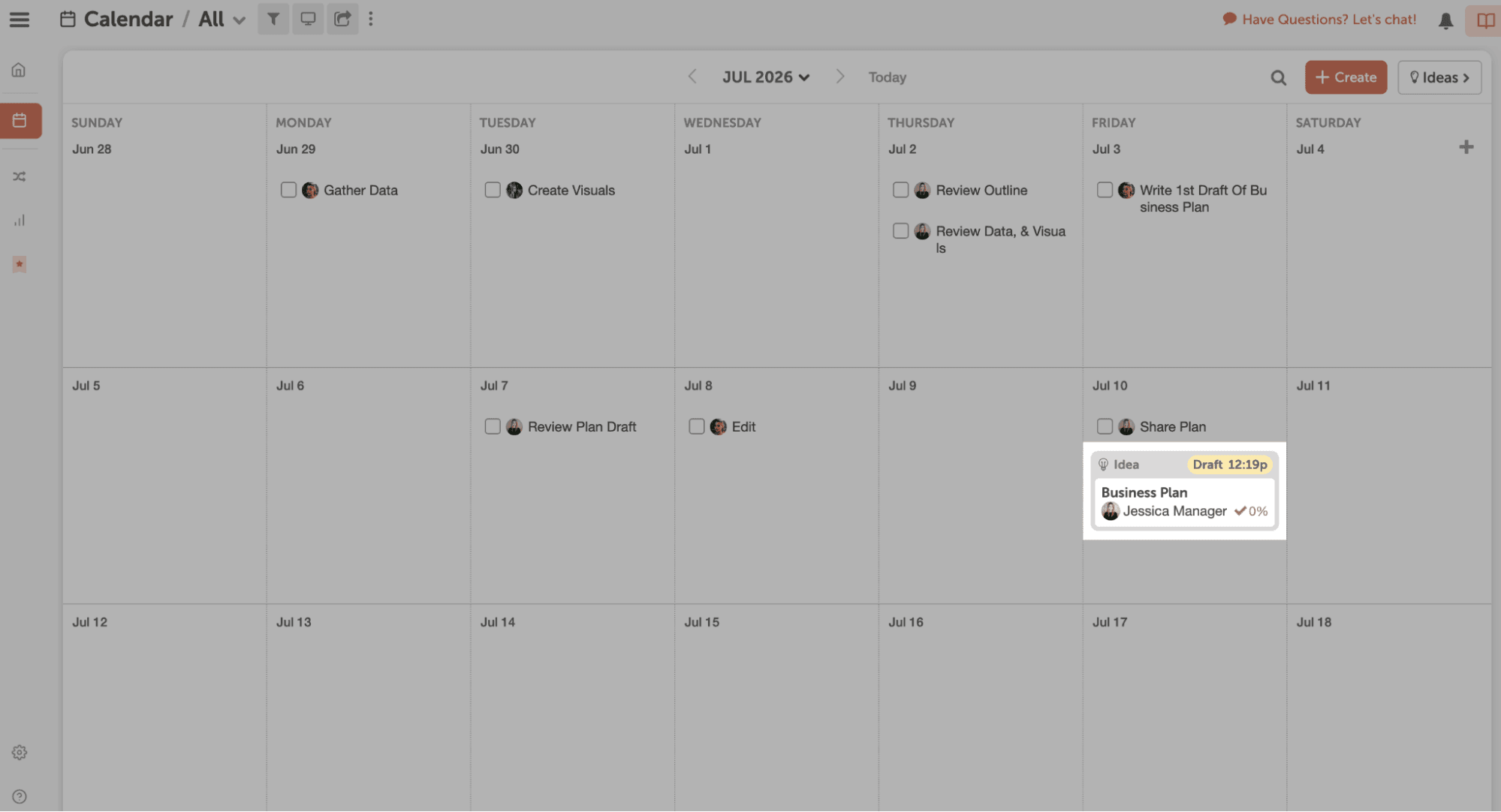How To Write A Business Plan: A Guide For Entrepreneurs (2023)
 Successful entrepreneur and technology investor, Anthony Pompliano, tweeted why entrepreneurs must learn how to write a business plan.
Here’s what he said:
Successful entrepreneur and technology investor, Anthony Pompliano, tweeted why entrepreneurs must learn how to write a business plan.
Here’s what he said:
 View on Twitter.
Did he invest in the business? You bet!
The takeaway from Anthony’s tweet is clear. A standout business plan lets investors see your idea's viability, which could open the floodgate of investment.
A solid business plan is crucial even if you’re bootstrapping your business. Ethan Mollick, Professor and author of The Unicorn's Shadow, summarizes what you can expect by writing a business plan. In Ethan’s words, “A business plan increases your chance of success by 10-20%.”
Perhaps you’re aware of the benefits of a business plan. Yet, the mere thought of writing your business plan bores you to tears, and you’d rather watch paint dry!
That’s why you need a detailed guide that makes the business plan writing process stress-free. In this guide, I’ll walk you through a step-by-step process for writing a winning business plan.
View on Twitter.
Did he invest in the business? You bet!
The takeaway from Anthony’s tweet is clear. A standout business plan lets investors see your idea's viability, which could open the floodgate of investment.
A solid business plan is crucial even if you’re bootstrapping your business. Ethan Mollick, Professor and author of The Unicorn's Shadow, summarizes what you can expect by writing a business plan. In Ethan’s words, “A business plan increases your chance of success by 10-20%.”
Perhaps you’re aware of the benefits of a business plan. Yet, the mere thought of writing your business plan bores you to tears, and you’d rather watch paint dry!
That’s why you need a detailed guide that makes the business plan writing process stress-free. In this guide, I’ll walk you through a step-by-step process for writing a winning business plan.
What Is A Business Plan?
Business Plan
A business plan is a document that describes your business idea and your plan to turn the idea into a profitable business.
Why Is A Business Plan Crucial?
Over 50% of entrepreneurs start their businesses without a plan. If you seek investment funding, this is a no-no. A business plan gives you a better chance of getting a ‘Yes’ from investors. Here are two reasons to have a business plan, even if you’re bootstrapping.1. Business Planning Ensures Resource Optimization
A CB Insights report says, “Running out of cash is one of the top 12 reasons startups fail.” This means that a conservative use of funds is crucial to the survival of your business. When you develop your business plan, you compel yourself to consider the various aspects of the business. The result? You deploy resources efficiently and preempt mistakes that could cost you time, money, energy, and your business.2. Business Planning Enables You To Plan For A Strong Startup Team
The quality of your startup team is vital to the success of your business. View on Twitter.
Even if your idea is the best since sliced bread, you still need the best people working with you. Writing a business plan allows you to plan for an A+ team, which can boost your odds of success.
Bottom line: Building a business without a business plan is like navigating a ship without a map. You could go around in circles and spend your funds until the business grinds to a halt.
If you don’t want that, you need to know how to write your business plan to stay on track.
View on Twitter.
Even if your idea is the best since sliced bread, you still need the best people working with you. Writing a business plan allows you to plan for an A+ team, which can boost your odds of success.
Bottom line: Building a business without a business plan is like navigating a ship without a map. You could go around in circles and spend your funds until the business grinds to a halt.
If you don’t want that, you need to know how to write your business plan to stay on track.
How To Write A Business Plan In 7 Simple Steps
Business plans fall into two categories:- A lean business plan:
- A traditional business plan:
Step 1: Write An Interesting Executive Summary
 Check out the full video here.
The executive summary is the introduction and one of the most important sections of your business plan. Interested business parties, like investors and lenders, may read just your executive summary. That’s because they are time-strapped and have many schedules on their plate.
An executive summary is like the headline of a newspaper article. If it doesn’t grab the reader’s attention, they lose interest and toss it aside.
Your executive summary should provide a high-level overview of your business concept. Like an elevator pitch — but with more detail — it conveys what your business does, who it’s for, why it’s different, and why it’ll be successful.
The purpose of your executive summary is to sell your business idea and its profit potential. Done right, it intrigues readers enough to thumb through the remaining pages.
Your executive summary should be under 2 pages and answer the following questions:
Check out the full video here.
The executive summary is the introduction and one of the most important sections of your business plan. Interested business parties, like investors and lenders, may read just your executive summary. That’s because they are time-strapped and have many schedules on their plate.
An executive summary is like the headline of a newspaper article. If it doesn’t grab the reader’s attention, they lose interest and toss it aside.
Your executive summary should provide a high-level overview of your business concept. Like an elevator pitch — but with more detail — it conveys what your business does, who it’s for, why it’s different, and why it’ll be successful.
The purpose of your executive summary is to sell your business idea and its profit potential. Done right, it intrigues readers enough to thumb through the remaining pages.
Your executive summary should be under 2 pages and answer the following questions:
- What problem do you solve?
- Who are your target customers?
- What product/service do you sell, and how is it different from what competitors offer?
- If you launched already, what are your sales and revenue thus far?
- What are your projections for sales and profitability?
- Why should an investor be excited about your idea?
Step 2: Describe Your Company
Your company description is the second component of your business plan. This section shows who you are, the problems your business solves, your goals, and why you are different. I’ll illustrate using Yellow Leaf Hammocks. Check out the full Yellow Leaf Hammocks page.
Check out the full Yellow Leaf Hammocks page.
- Who they are: makers of the “world’s most comfortable” hammocks
- Their goal: empower their weavers—craftswomen from Northern Thailand—to break the cycle of poverty
- Why they’re different: They achieve their goals through training and sustainable job creation.
- An advisory board that makes up for any lack of experience you may have.
- Industry experience.
- Business model.
- Business mission and vision.
- Business name, registered address, and contact information.
- Founding story — how you came about your idea and why you pursued it.
- Business structure — sole proprietorship, partnership, or limited liability company (LLC). Include the ownership stake of every party as well.
- Management team, including their professional background, unique skills, and expertise.
- Short-term goals (achievable within 12 months) and long-term goals (achievable within 5 years).
Step 3: Share Your Market Analysis
Is the size of your total addressable market big enough? Use this section to discuss your target market, the results of your market research, and how you plan to grab a huge amount of market share. Your market analysis should prove: 1. You’ve validated your idea. It’s not enough to claim an understanding of your target customers and their needs. You must also provide Proof of Concept (POC), i.e., data-based evidence that your idea is workable. As American management consultant W. Edwards Deming said, “Without data, you’re just another person with an opinion.” And it’s dangerous to base your business on opinions alone. Often, many entrepreneurs skip this crucial step, remain blinded by their enthusiasm, and assume there’s a market for their product. This is incorrect. 35% of businesses die in infancy because there’s no market need for their product. Strong and growing sales numbers are the most effective way to prove there is demand for your business. However, if you’ve yet to launch your business, you can test the feasibility of your idea with the lean start-up methodology. 2. You’ve analyzed your competitors and identified your competitive edge. Have you thought hard about how you compare to your competitors? Expert-level understanding of your business environment is crucial to your success. To achieve this, conduct a thorough competitive analysis, do a SWOT analysis, and share your results. The outcome of your analysis equips you to:- Define your competitive advantages.
- Clarify your unique selling proposition (USP).
- Develop strategies that outperform competitors.
- Choose the best marketing approaches for your products/services.
Step 4: Describe Your Products Or Services
While your products and services may appear in multiple sections of the plan, it’s great to have a section that describes how they work. For instance, if you have four physical products, it makes sense to describe all of them so that readers understand how they work and what makes them unique. If you have many products, pick a few and describe them. For tech products, share information about your product's front and back end. Always keep your explanations simple. Don’t assume readers have industry experience. Don’t make them work hard to understand your products and services. Note that if your product is a commodity item, elaborate descriptions are unnecessary. But if you’re creating a new product, share insights about how you plan to protect your intellectual property with patents, trademarks, etc.Step 5: Present Your Sales & Marketing Strategies
How will you spread the word about your business? “If you build it, they will come” is a dangerous myth. The reality is this: businesses never live up to their sales potential without effective marketing efforts. That’s why you should invest time in building your marketing plan. Recognize that your business needs repeat business to thrive, not one-time sales. Your marketing plan should include strategies both for acquiring and retaining customers. Key information for this section includes:- Impact and results of past marketing efforts
- Clear, realistic, and measurable sales targets
- Goals for future marketing efforts
- Deadlines for meeting set goals.
- Budget for all marketing activities.
- Marketing channels (e.g., word of mouth, social media, advertising, direct-to-consumer, retail stores, e-commerce, etc.)
Step 6: Share Your Financial Projections
Your financial projection helps investors and lenders know if your business will make a profit. It compares your operating costs with your projected sales and profit to see if your business will be profitable. Keep in mind that a financial projection isn't merely a prediction. It implies a commitment to achieving the targeted results. Essential information to include in this section:- Projected sales over the next 18- 36 months, including high, medium, and low sales estimates
- Total costs of producing goods, including marketing, promotion, commissions, administration, salaries, etc.
- Profit and loss projections
- Break-even analysis
- Projected cash flow
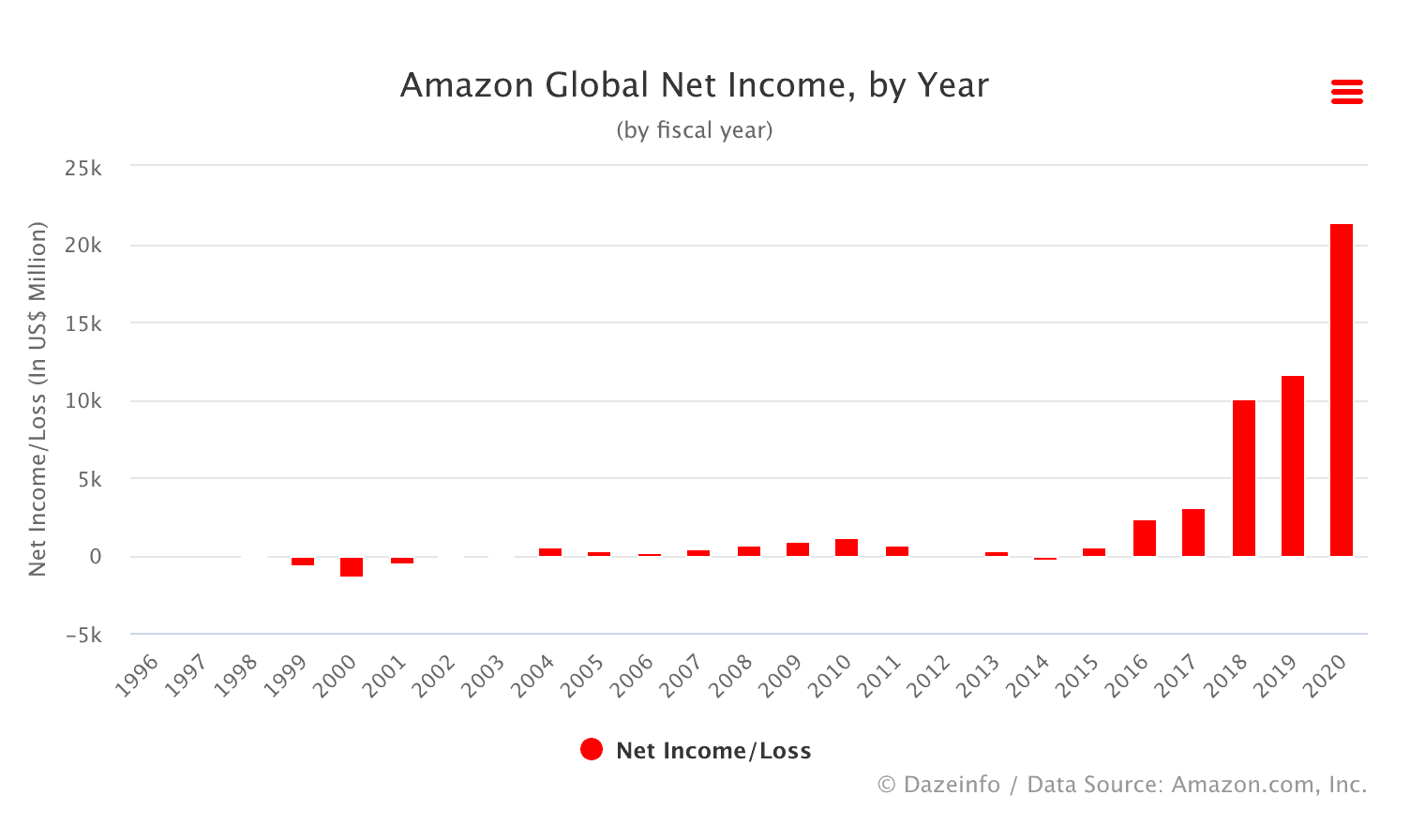 View the page here.
View the page here.
Step 7: Outline Your Operations & Management Plan
The operations and management plan describes how your business will operate, and it’s the concluding section of the business plan. It provides a high-level overview of your workflows, production processes, supply processes, administration, and so forth. Elements of your operations and management plan include:- Organizational structure, i.e., who is in charge of each aspect of the business
- Expense and capital requirements to support the organizational structure
- Facility, equipment, and supply requirements
- Initial personnel requirements
Plan, Write, & Share Your Business Plan Using Marketing Calendar
CoSchedule’s Marketing Calendar allows you to schedule, manage, and track your marketing efforts in one place. With Marketing Calendar, you can coordinate, execute, and share your business plan, so everything goes smoothly from start to finish.1. Create A Project For Your Business Plan
Add a business plan project to your calendar on the day you intend to publish the post.2. Schedule Your Business Plan Projects
Select the date that you want your business plan completed by to ensure tasks are scheduled before that date.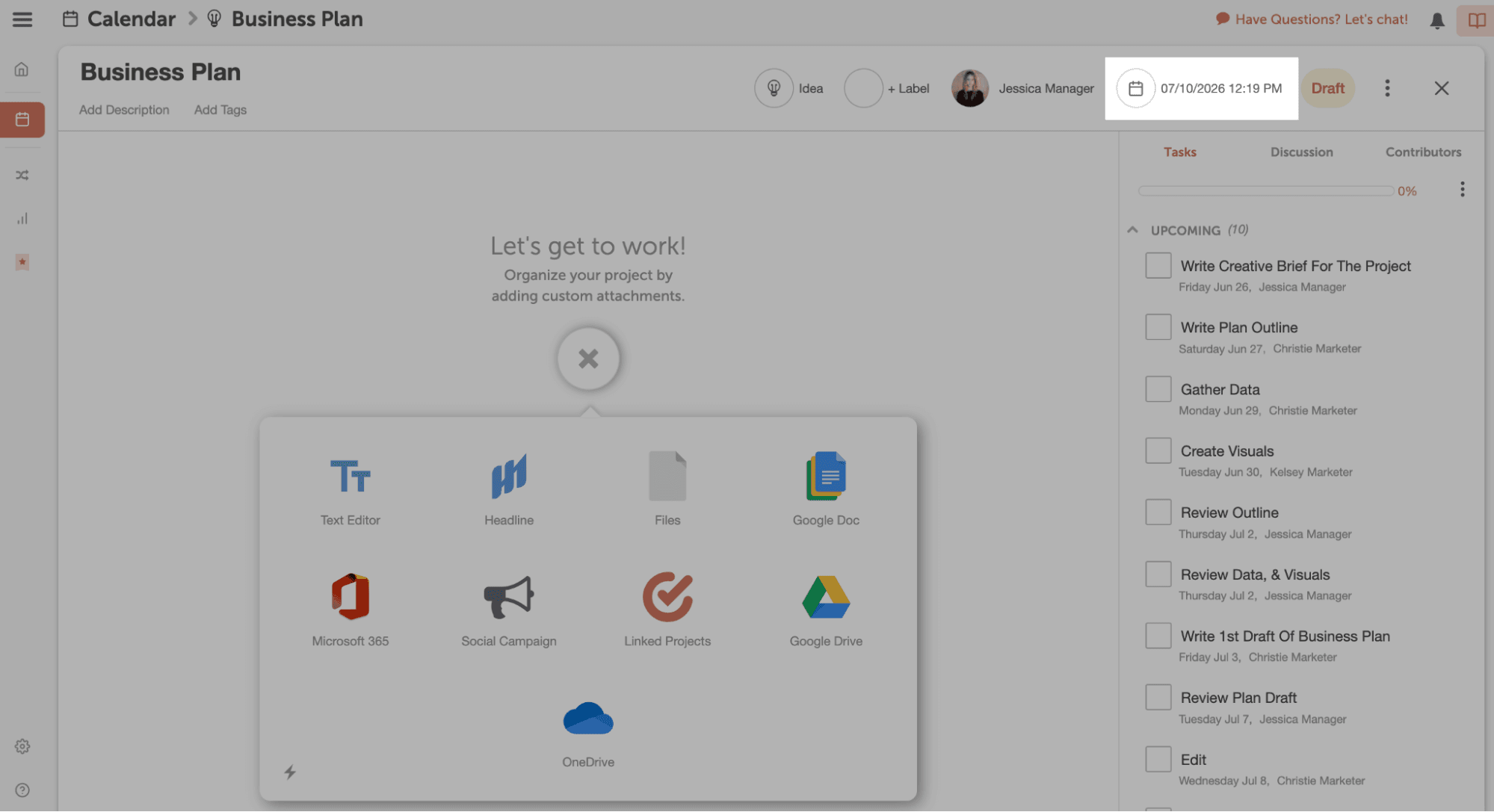
Add Tasks
Write a list of tasks to complete the business plan without missing any details.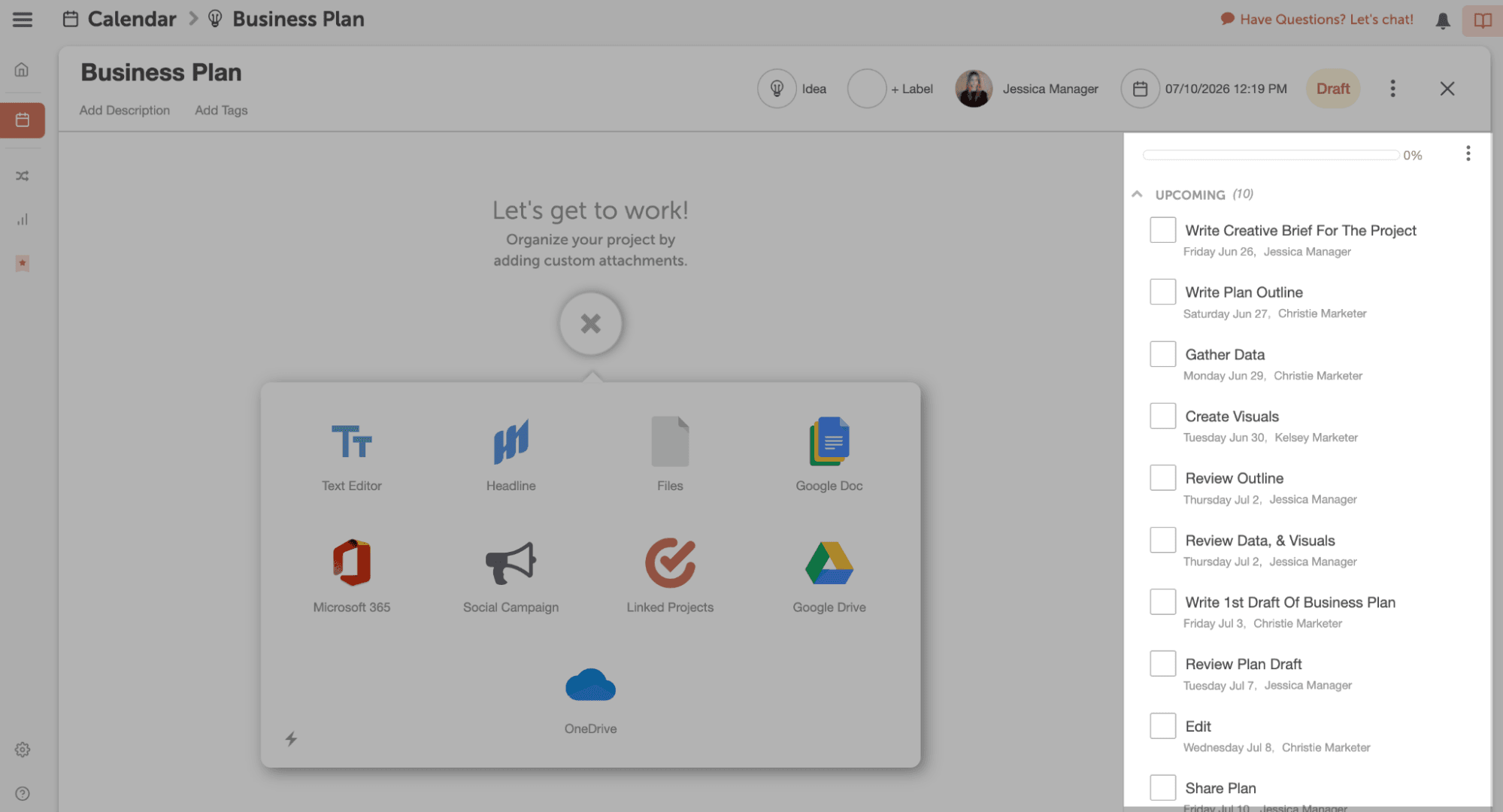
- Write A Creative Brief For The Project
- Objectives
- Audience
- Write Plan Outline
- Information to include
- Gather Data
- Create Visuals
- Review Outline
- Review Data, & Visuals
- Write 1st Draft
- Sub-tasks
- Summarize key findings
- Write introduction
- Write body
- Recommend an action plan
- Sub-tasks
- Review Plan Draft
- Make Edits
- Distribute The Plan To Stakeholders
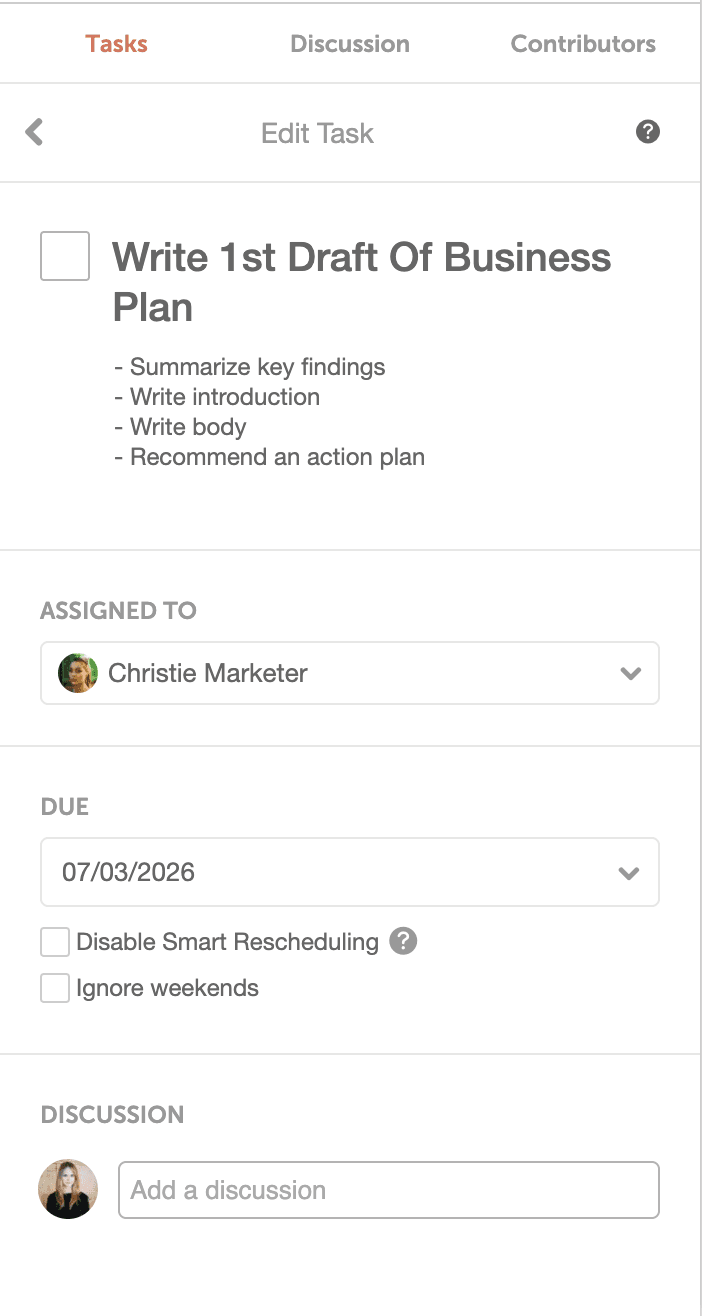
Attach Documents
Add additional documentation to your business plan project. From financial statement files to the first draft, access all the necessary documents in the project to keep everything stored in one place.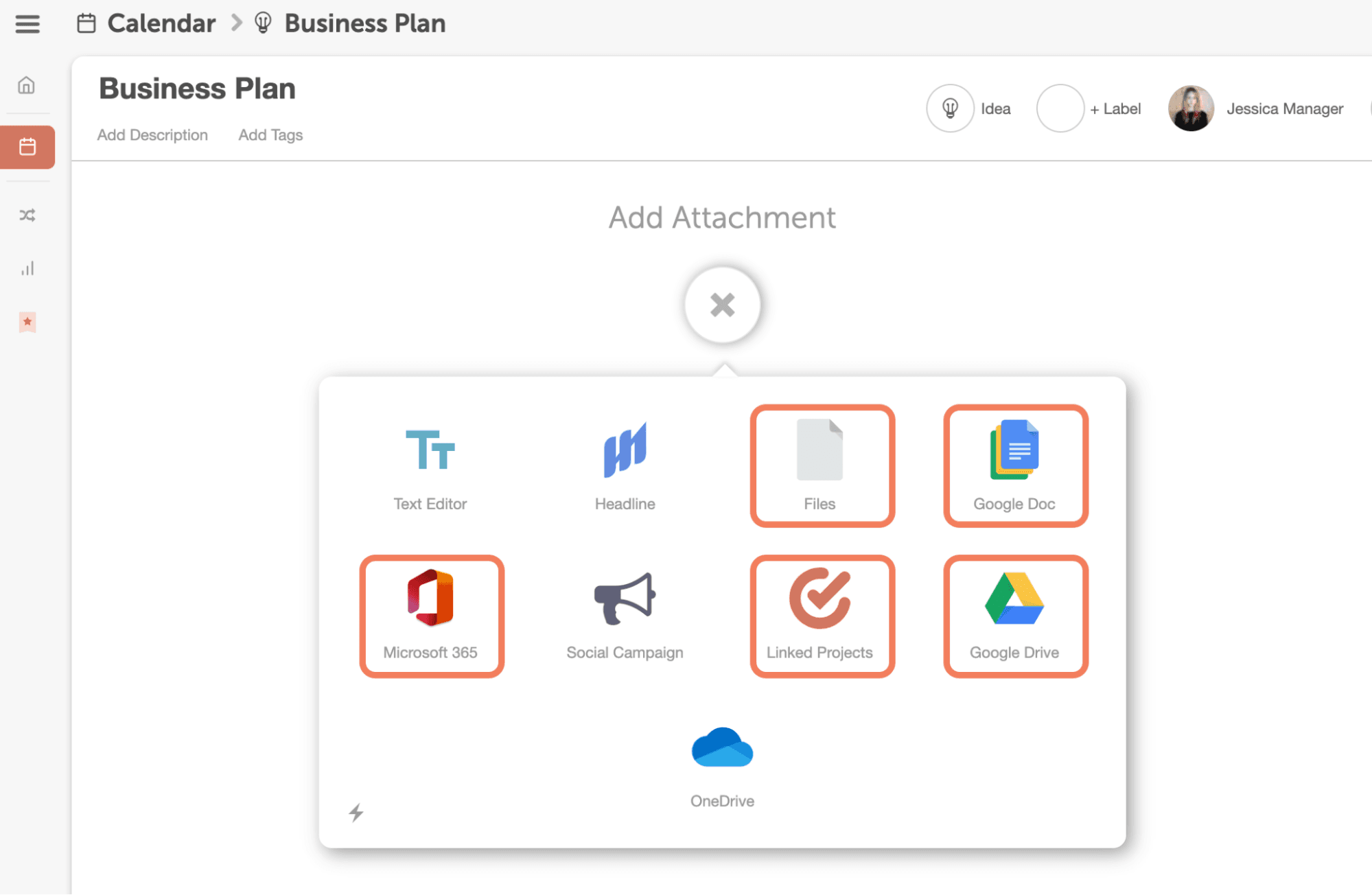 Additional Document Ideas
Additional Document Ideas
- Financial Statement Files
- Outline Document
- Draft Copy
- Images
- Graphic Data
- Additional Projects
Add Business Plan Details To The Project
Outline important business plan details in the Text Editor attachment to provide instructions or add needed information to set your team up for success. From the names of stakeholders to company background, write information that is prevalent to the business plan for the whole team to access.
From the names of stakeholders to company background, write information that is prevalent to the business plan for the whole team to access.
3. Delegate Tasks To Your Team
Make sure every task is completed on time by delegating duties to each team member. Add completion dates under each task to set deadlines.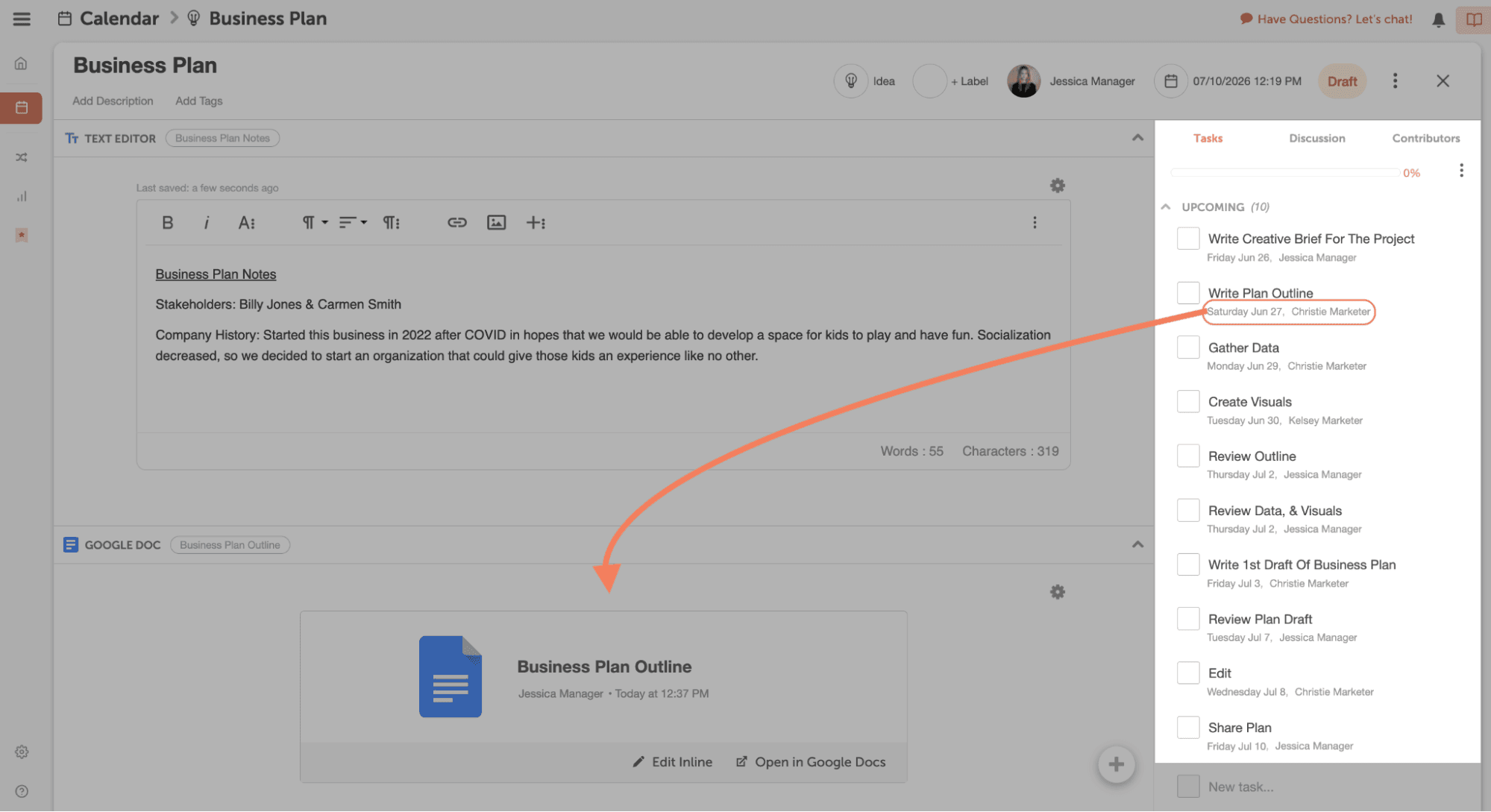
4. Share Your Business Plan With Stakeholders
Click on the three-dot menu of the project to share any part of your business plan project with stakeholders. CoSchedule’s Marketing Calendar allows you to share read-only views of project attachments. Distribute sharable links or PDF versions of documents to easily present your business plan to stakeholders.
CoSchedule’s Marketing Calendar allows you to share read-only views of project attachments. Distribute sharable links or PDF versions of documents to easily present your business plan to stakeholders.
 Pro Tip: Share progress throughout the project with stakeholders by sharing the read-only links with stakeholders.
Pro Tip: Share progress throughout the project with stakeholders by sharing the read-only links with stakeholders.
